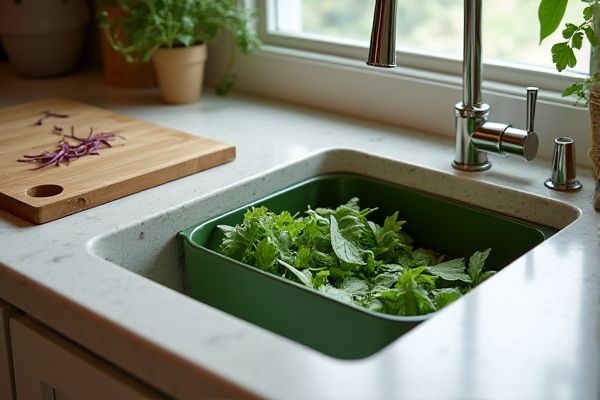
Countertop compost bins offer convenience and easy access for everyday food scraps, while under-sink compost bins save valuable kitchen space and typically feature odor-control mechanisms. To learn which option best suits Your kitchen habits and environmental goals, read the rest of the article.
Table of Comparison
| Feature | Countertop Compost Bin | Under-Sink Compost Bin |
|---|---|---|
| Location | On kitchen counter, easily accessible | Under the sink, hidden from view |
| Capacity | Small to medium (1-2 gallons) | Medium to large (3-5 gallons) |
| Odor Control | Built-in charcoal filters or tight lids | Improved ventilation with filters; less odor due to enclosed space |
| Ease of Use | Quick access, ideal for frequent food waste disposal | Less immediate access, suitable for storing waste until full |
| Cleaning | Smaller size, easy to clean regularly | Larger size, may require less frequent cleaning but can be bulkier |
| Space Efficiency | Occupies countertop space, may reduce work area | Utilizes under-sink space, preserves countertop area |
| Material | Often plastic or stainless steel | Durable plastic or metal options available |
| Price Range | Generally $15 - $50 | Typically $30 - $70 |
Introduction to Home Composting Solutions
Home composting solutions include countertop compost bins and under-sink compost bins, each designed to facilitate organic waste recycling efficiently. Countertop bins offer convenience and easy access for daily food scraps, often featuring charcoal filters to control odors. Under-sink compost bins maximize space utilization in the kitchen, providing larger capacity and discreet waste management for eco-friendly households.
What Is a Countertop Compost Bin?
A countertop compost bin is a compact container designed to collect kitchen scraps and organic waste directly on your kitchen counter for easy access and convenience. It typically features a charcoal filter to control odors, making it ideal for small spaces and daily use. Unlike under-sink compost bins, it offers quicker visibility and ease of emptying, helping you manage food waste efficiently.
Understanding Under-Sink Compost Bins
Under-sink compost bins offer a discreet and space-saving solution for collecting kitchen waste, typically measuring between 1 to 3 gallons to fit cabinet spaces beneath the sink. These bins often feature airtight lids and charcoal filters to control odors effectively, making them ideal for households seeking a cleaner composting method. Unlike countertop compost bins, under-sink variants reduce clutter on kitchen surfaces while providing easy access for quick waste disposal during meal preparation.
Space Requirements: Countertop vs Under-Sink
Countertop compost bins typically require limited surface space, making them ideal for small kitchens with available counter area but may contribute to clutter. Under-sink compost bins utilize unused cabinet space beneath the sink, freeing up countertop real estate while offering larger capacity for food scraps. Choosing between the two depends on kitchen layout, with countertop bins favoring convenience and under-sink bins prioritizing efficient use of hidden space.
Odor Control and Hygiene Comparison
Countertop compost bins typically feature airtight lids and charcoal filters that effectively control odors in small kitchen spaces, maintaining hygiene by preventing the escape of food scraps' smell. Under-sink compost bins benefit from being tucked away in a cooler, enclosed cabinet area, which naturally reduces odor diffusion but may require more frequent cleaning to prevent mold and bacteria buildup due to limited air circulation. Both types demand regular maintenance, but countertop bins offer superior odor management through advanced filtration, while under-sink bins prioritize discreet placement at a slight compromise to ventilation and odor control.
Capacity and Frequency of Emptying
Countertop compost bins generally offer smaller capacities, typically holding 1 to 2 gallons, which requires more frequent emptying--often every few days--to prevent odors and maintain hygiene. Under-sink compost bins have larger capacities, ranging from 3 to 5 gallons or more, allowing for less frequent emptying, usually once a week, making them ideal for busy kitchens with higher compost output. Choosing the right bin depends on your available space and how often you're willing to manage compost disposal.
Ease of Access and Convenience
Countertop compost bins offer superior ease of access as they remain within arm's reach during food preparation, allowing for quick disposal of scraps without leaving the kitchen area. Under-sink compost bins, while less accessible, help maintain a clutter-free countertop and often provide larger capacity, reducing the frequency of emptying. Choosing between the two depends on prioritizing immediate convenience versus maximizing kitchen space and compost volume.
Maintenance and Cleaning Differences
Countertop compost bins require frequent emptying and thorough cleaning to prevent odors and pest attraction due to their small capacity and constant kitchen exposure. Under-sink compost bins feature larger volume and often include ventilation systems, reducing odor buildup but necessitating periodic deep cleaning to prevent mold and bacterial growth in enclosed spaces. Maintaining countertop bins involves daily attention, while under-sink bins demand less frequent but more intensive sanitation efforts.
Aesthetic and Design Considerations
Countertop compost bins often feature sleek, modern designs with materials like stainless steel or ceramic that complement kitchen decor, making them an attractive and convenient option for Your food scraps. Under-sink compost bins prioritize space-saving functionality and typically have a more utilitarian, discreet appearance that blends seamlessly beneath cabinetry. Choosing between the two depends on whether You value visible, stylish design or prefer hidden, practical storage for composting waste.
Which Compost Bin Suits Your Lifestyle?
Countertop compost bins offer convenience and accessibility, ideal for small kitchens or frequent composters who prefer immediate waste disposal. Under-sink compost bins provide larger capacity and odor control, suitable for households generating more organic waste and seeking a discreet setup. Assess your kitchen size, composting frequency, and odor management needs to determine which compost bin suits your lifestyle best.
 homyna.com
homyna.com